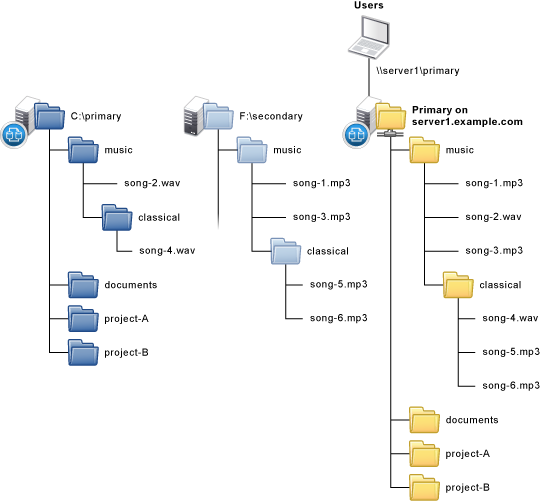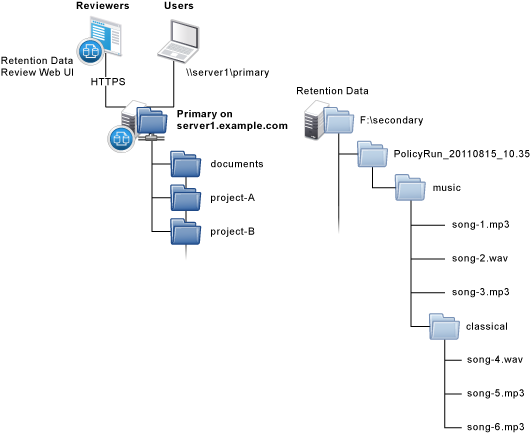8.1 Understanding Pairs
A Dynamic File Services pair is a logical combination of two independent storage locations that are managed as one. There are two pair types to address your storage needs: a standard pair and a retention pair. These concepts are described in more detail below.
8.1.1 Pair Paths
A pair consists of two independent share paths. The two paths in a pair are referred to as primary and secondary. The primary location typically contains the most important and most used files. The secondary location typically contains less critical or seldom-used files, very large files, or files that change infrequently. The administrator determines what files should reside in each location.
Paths are supported on the following devices:
|
Pair Type |
Primary Path |
Secondary Path |
|---|---|---|
|
Standard pair |
|
|
|
Retention pair |
|
|
The primary location typically resides on higher-performance storage hardware than the secondary location. The secondary path can even be connected over lower-speed connections such as cloud-based iSCSI. Retention pairs also support cloud storage for the secondary location. Local devices include drives that are attached directly to the server or are attached via Fibre Channel and iSCSI connections. Remote shares can reside on network attached storage (such as NetApp and EMC filers) and supported Windows server platforms. Remote shares must reside in the same Active Directory domain or the same workgroup as the DynamicFS server. Cloud storage involves your accounts with a cloud provider that you have configured to allow the Dynamic File Services application to access files.
8.1.2 Standard Pairs
The Dynamic File Services standard pair allows you to efficiently manage your storage across a pair of paths while giving users access to files on both. When users connect to a network share on the primary path, they see merged view of files. Users are not aware of where the files physically reside. Files on both paths are equally accessible to users. Dynamic File Services pulls data directly to the user from the primary path or the secondary path, depending on where the file is located.
For the standard pair, the Dynamic File Services filter driver works with a network share on the primary path to give users a merged view of the files on both the primary and secondary locations.
For example, Figure 8-1shows a primary path of C:\primary, a secondary path of F:\secondary, and the merged view of the files in the pair as seen by the users via the network share.
Figure 8-1 Merged View of the Primary and Secondary Paths

The merged view is not automatically presented to users of a pair. To enable users to see the merged view, you must use the Microsoft Network Share tool to create a network share on the primary path. For requirements and guidelines, see Section 4.14, Merged View for Standard Pairs.
8.1.3 Retention Pairs
The Dynamic File Services retention pair allows you to keep data that is actively used on the primary path, and to move static data that you rarely need to access to a retention repository on the secondary path. For example, you can use the repository to store files that are not needed for everyday operations but must be retained for historical reference, or to comply with contractual or legal requirements. Files in the repository are not generally available to users. Only designated reviewers can access them via a Web-based Retention Review Service. You can schedule retention review events and notify multiple recipients about them. Reviewers determine the disposition of retained files in accordance with your company’s data retention policy. All retention review actions are audited.
For example, Figure 8-2shows a primary path of C:\primary, a secondary path of F:\secondary. The retention repository contains folders with files that were moved during a particular policy run or pair option.
Figure 8-2 Retention Repository as the Secondary Path
